Bugs in our Backyard allows you to contribute to on-going research on the distribution of insects in our communities. Several different surveys target different plant and insect species. So wherever you live, chances are, you can contribute to the project! Read the descriptions below to decide where you can best help gather data, or check out our free Field Guide to see what plants and insects are near you!
Golden Raintree/ Soapberry Bug Survey
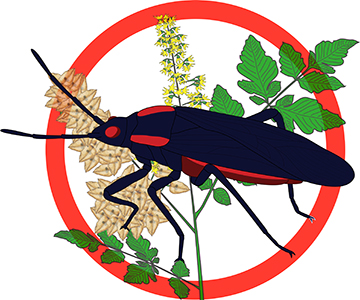 The soapberry bug species Jadera haematoloma is one of the most interesting true bugs in America. These insects originated in Florida, along the Gulf Coast, and in isolated interior river valleys, where they fed on native plants in the soapberry family. Early in the 20th century, urban developers introduced the golden raintree (Koelreuteria sp.) from China, and J. haematoloma evolved rapidly to exploit this new food source. Golden rain trees have been planted in urban and suburban areas throughout the US, and the soapberry bugs have moved north following this human urban development. But there’s a twist: not all soapberry bugs can fly! Many of them have short, non-functional wings.
The soapberry bug species Jadera haematoloma is one of the most interesting true bugs in America. These insects originated in Florida, along the Gulf Coast, and in isolated interior river valleys, where they fed on native plants in the soapberry family. Early in the 20th century, urban developers introduced the golden raintree (Koelreuteria sp.) from China, and J. haematoloma evolved rapidly to exploit this new food source. Golden rain trees have been planted in urban and suburban areas throughout the US, and the soapberry bugs have moved north following this human urban development. But there’s a twist: not all soapberry bugs can fly! Many of them have short, non-functional wings.
→ By reporting the locations of golden rain trees, you can help us document the potential resources available to J. haematoloma. By reporting occurrences of the soapberry bugs– and telling us about their wing length– you can further help us understand how this variation in wing development helps or hinders their range expansion.
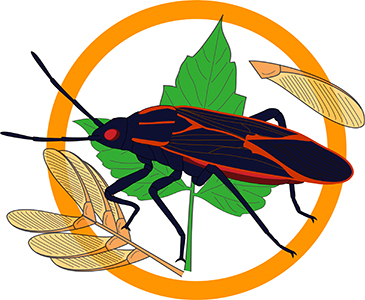 The boxelder bugs, Boisea trivittata and B. rubrolineata, are native true bugs in the US that feed on the seeds of the boxelder or other maple trees (Acer sp.). These bugs are typically harmless to the trees that host them and pose no danger to humans. However, they can occasionally form huge aggregations with thousands of individuals at one location.
The boxelder bugs, Boisea trivittata and B. rubrolineata, are native true bugs in the US that feed on the seeds of the boxelder or other maple trees (Acer sp.). These bugs are typically harmless to the trees that host them and pose no danger to humans. However, they can occasionally form huge aggregations with thousands of individuals at one location.
→ By reporting boxelder bug aggregations you can help us understand the boom-or-bust population dynamics of this species.
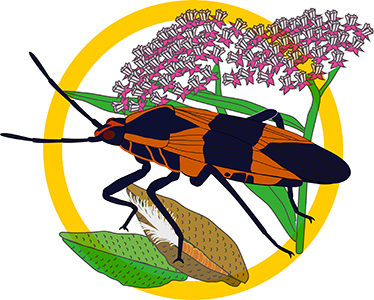 Milkweed is a common native plant that hosts a unique community of insects. These plants produces cardenolides, and relatively few insects have evolved the ability to tolerate this toxic chemical. Many of these insects internalize the cardenolide to defend themselves, and advertise their toxicity with bright colors. The iconic Monarch butterfly is one milkweed insect, as are several different species of true bugs and beetles.
Milkweed is a common native plant that hosts a unique community of insects. These plants produces cardenolides, and relatively few insects have evolved the ability to tolerate this toxic chemical. Many of these insects internalize the cardenolide to defend themselves, and advertise their toxicity with bright colors. The iconic Monarch butterfly is one milkweed insect, as are several different species of true bugs and beetles.
→ Help us document the diversity of the milkweed insect community across the US!
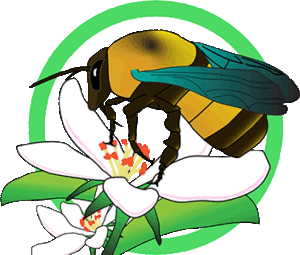 Everyone loves bumble bees! With a gentle hum, these fuzzy creatures float among the flowers. As they go, they perform an essential service to the ecosystem, pollinating the plants they visit. While they may seem common, these charming creatures have declined in their numbers and in their species diversity in recent decades. Bugs in our Backyard is part of efforts to document bumble bee diversity across the Gulf of Maine. As citizen scientists, you can help too!
Everyone loves bumble bees! With a gentle hum, these fuzzy creatures float among the flowers. As they go, they perform an essential service to the ecosystem, pollinating the plants they visit. While they may seem common, these charming creatures have declined in their numbers and in their species diversity in recent decades. Bugs in our Backyard is part of efforts to document bumble bee diversity across the Gulf of Maine. As citizen scientists, you can help too!
→ Help us document the diversity of bumble bee species in the Gulf of Maine area – coastal regions of Massachusetts, New Hampshire, Maine, New Brunswick or Nova Scotia.
Open-Ended Survey
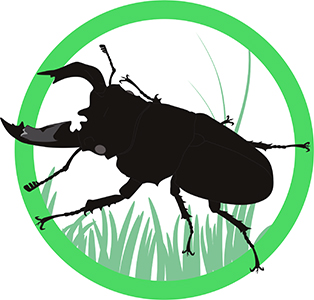 Perhaps you live in an area where the plants and insects mentioned above aren’t found. There are still interesting insects in your backyard! Bugs In Our Backyard will provide step-by-step instructions (Coming Soon!) on how to submit observations of insects and other living things to iNaturalist. This open-ended survey allows you to report any insects you might find and any associations they may have with plants.
Perhaps you live in an area where the plants and insects mentioned above aren’t found. There are still interesting insects in your backyard! Bugs In Our Backyard will provide step-by-step instructions (Coming Soon!) on how to submit observations of insects and other living things to iNaturalist. This open-ended survey allows you to report any insects you might find and any associations they may have with plants.
→ By documenting the insects in your area you can provide important data on biodiversity. This information can be useful in studies of community ecology, species movements, climate change, and other questions we haven’t even thought of yet!
The data from all these citizen science surveys will be curated and posted publicly here. Besides data-gathering, your involvement as a citizen scientist can include data analysis. Think creatively about what these data can tell you, and let us know what you find in blog post comments or email.
